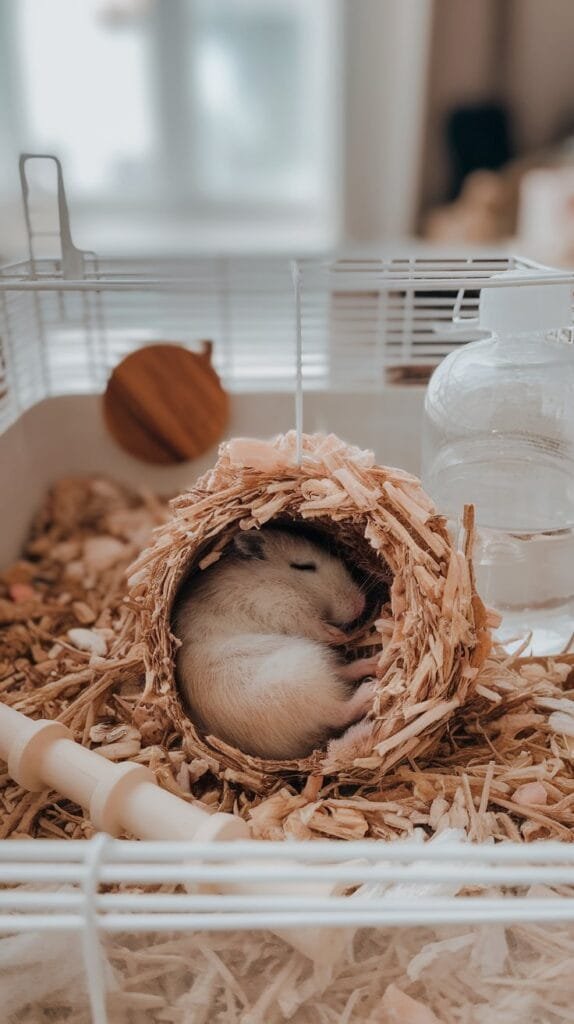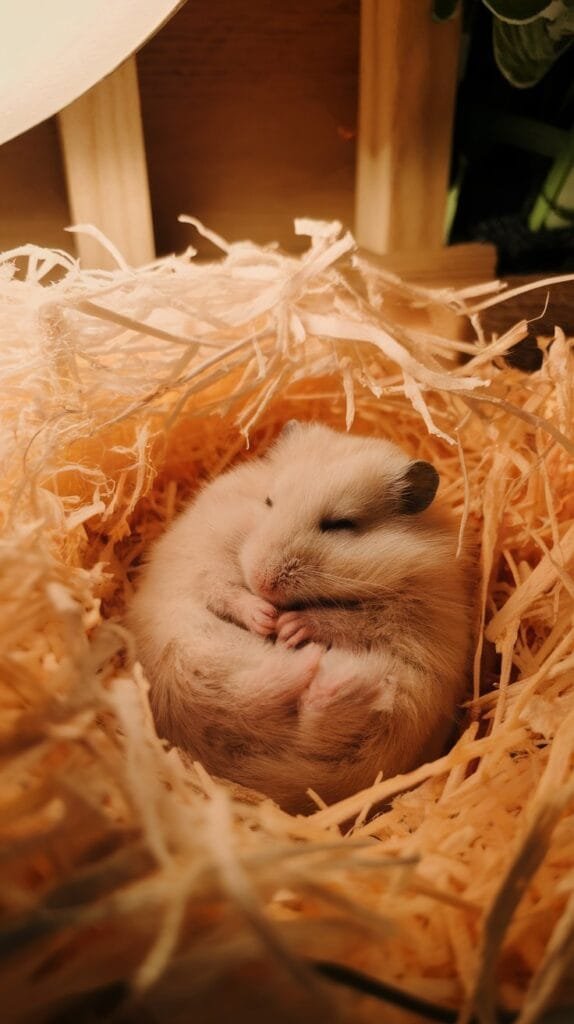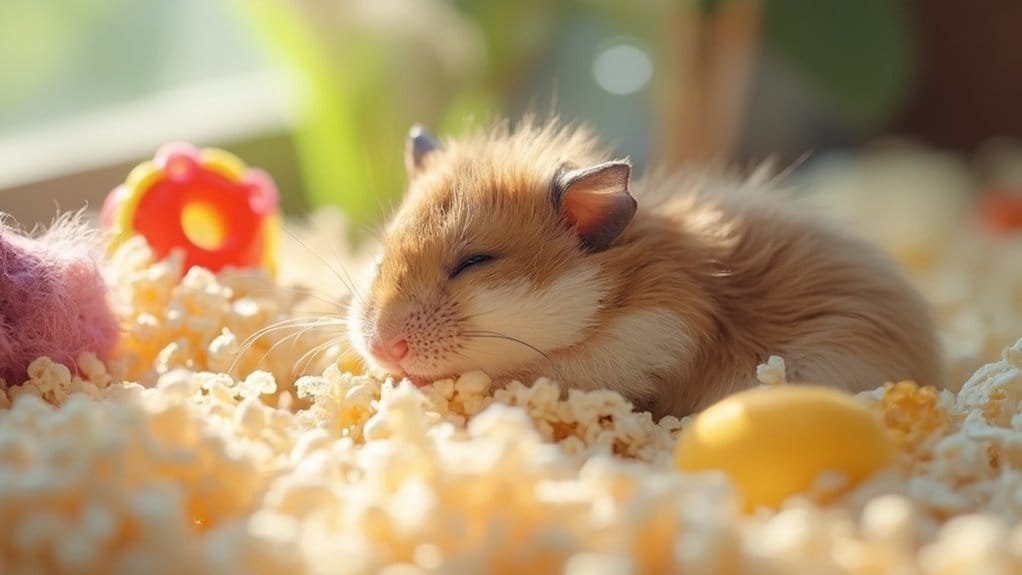If your hamster seems to always be sleeping, don’t fret! These little furballs snooze around 12 to 14 hours a day, mostly in the daytime. You see, hamsters are crepuscular, meaning they’re more active at dawn and dusk. Think of them as little fluffy vampires! They just love their beauty sleep to recharge for their nighttime adventures. But, if your hamster is sleeping excessively or seems lethargic, it could be a sign of stress or illness. Keep an eye on them—after all, a comfy cage and a quiet spot can make a big difference! Want to learn more about their habits?
Understanding Hamster Behavior
Understanding hamster behavior is crucial for ensuring their well-being and happiness. You know, these little furballs have some quirky habits! Take burrowing, for example. In the wild, they dig to stay safe from predators. When you change their bedding, they instinctively start burrowing again, like they’re redecorating their cozy little home. Isn’t that cute?
Hamsters also love to hide. They’ll burrow into their bedding or snuggle into toys, feeling secure and safe—just like we do when we cuddle up with a blanket during a scary movie. This instinct to seek out safe hideouts is essential for their sense of security.
And let’s not forget their hoarding habits! They stash food in those hidden spots, preparing for their midnight snacks. It’s a bit like how you might hide your Halloween candy from your siblings.
Plus, they adapt to their environment, creating burrows that help them feel comfy and manage temperature. So, when you see your hamster digging or hiding, just remember—it’s not just a random act; it’s all part of their natural behavior that keeps them happy and healthy.
Isn’t it fascinating to think about how these tiny creatures navigate their world?
Nocturnal vs. Crepuscular Activity
Have you ever noticed your hamster running on its wheel at odd hours? It might seem like they’re nocturnal, but here’s the twist—hamsters are actually crepuscular! That means they love to be active at dawn and dusk. It’s like they’re party animals but only for a few hours!
In the wild, hamsters forage during these times to dodge predators. But in captivity, they might act more nocturnal because, well, there aren’t any predators around to worry about. Your hamster’s behavior can really depend on their environment. Additionally, hamsters require approximately eight hours of sleep daily to maintain their health and well-being.
Here’s a quick look at the difference:
| Nocturnal Behavior | Crepuscular Behavior |
|---|---|
| Active throughout the night | Active at dawn and dusk |
| Syrian hamsters show this more | Wild hamsters forage during these times |
| Less active during the day | More natural activity pattern |
| Influenced by captivity | Adapted to avoid predators |
Sleep Duration and Patterns

Hamsters typically sleep around 6 to 8 hours a day, often taking short naps during the daytime. Imagine your little furry friend curling up in their cozy bedding, snoozing away after a busy night of exploring!
These cute critters have sleep cycles that last about 10 to 12 minutes, so they’re not in dreamland for long. They bounce between deep sleep and that fascinating REM sleep, where their tiny paws might twitch—cute, right?
Now, don’t be surprised if you notice your hamster being more active at dusk and dawn. That’s when they come to life! If your hamster seems to be sleeping a lot more than usual, it might be a sign of something else, like torpor or even an illness. Keep an eye on them; after all, you know your pet best!
Environmental factors play a big role too. If it’s too noisy or bright, their sleep can get disrupted. So, creating a calm, dark space is vital. Lack of sleep may also indicate underlying stress or health issues that need attention.
Regularly checking on their sleep habits helps you spot any issues early, keeping your little buddy happy and healthy—and we all want that, right?
Ideal Sleep Environment
How can you create the perfect sleep environment for your hamster? It’s easier than you might think! First, make sure their cage is in a dark, quiet spot. Hamsters love the dark, just like you might enjoy a cozy blanket fort.
Keep the temperature between 18-21°C, avoiding any drafts. Nobody likes a chilly breeze while they’re trying to nap, right?
Next, give your little buddy a deep layer of bedding—about 10 inches is ideal! Think of it as their plush mattress. Use safe materials like paper-based bedding or aspen shavings, and skip the harmful stuff like cotton wool. Providing deep bedding allows hamsters to engage in their natural digging behavior, which can enhance their comfort.
A nesting box or two will also give them a perfect hideaway for snoozing.
And don’t forget, a clean cage is a happy cage. You wouldn’t want to sleep in a messy room, so why should your hamster?
Plus, placing the cage in a quiet room, away from loud TVs or pets, will help them get the rest they need. With a little effort, you’ll create a sleep haven for your furry friend, and they’ll be ready to play when the sun sets!
Factors Disrupting Sleep
Several factors can disrupt your hamster’s sleep, impacting their overall health and well-being.
First off, think about where you’ve placed their cage. If it’s near a loud TV or the barking dog next door, your little buddy won’t catch a wink! Noise is a sleep thief.
Then there’s light exposure—hamsters are nocturnal, so too much light during their snooze time can throw them off. This is significant because their natural behavior includes being active during the night and sleeping during the day.
Don’t forget about temperature! If it’s too hot or too cold, your hamster might just burrow down and stay there.
Also, a dirty or cramped cage? That’s like trying to sleep on a pile of laundry—definitely not comfy!
What about diet? If you’re feeding them junk food or they’re not getting enough water, they might feel sluggish and cranky.
Hamster Sleep Phases

Understanding your furry friend’s sleep phases is vital for their well-being. Hamsters are pretty unique when it comes to snoozing. Did you know they sleep about 12 to 14 hours a day?
But don’t expect them to be like your cat, snoozing all in one go. Nope! They take lots of little naps throughout the day, kind of like how you might take a break during a long school day.
Now, here’s the fun part: each sleep cycle lasts about 10 to 12 minutes. That’s shorter than a TV commercial! Hamsters experience polyphasic sleep, so they have multiple segments of sleep throughout the day.
Syrian hamsters mightn’t hit REM sleep like we do, but Djungarian hamsters spend around 11% of their sleep time in that dreamy state. So, when your little buddy is curled up and twitching, they’re probably off chasing imaginary snacks.
Hamsters prefer to be active at dawn and dusk, not midnight like some people think. It’s like they’ve their own little morning and evening routines!
Health Indicators in Sleep
Hamster sleep patterns can reveal a lot about their health. If you notice your little buddy snoozing way more than usual, it might be time to take a closer look. Here are three key health indicators to watch for:
- Excessive Sleeping: If your hamster sleeps over 12 hours a day, it could mean something’s off.
- Changes in Sleep Schedule: Is your hamster up all night and sleeping during the day? That’s a red flag!
- Lack of Activity: If your furry friend is lounging around when they usually run like the wind, it’s worth investigating. Additionally, nocturnal behavior means that they should naturally be active during the night, so any deviation from this pattern can be concerning.
Pay attention to signs like weight loss or changes in eating habits, too. If their appetite’s gone south or their poops look funny, that’s another clue.
Even small things, like a noisy environment or a dirty cage, can mess with their beauty sleep. So, if your hamster seems a little off, don’t ignore it!
Keeping an eye on their sleep habits can help you catch any potential problems early. After all, a happy hamster is a healthy hamster!
Monitoring Your Hamster’s Sleep
Keeping an eye on your hamster’s sleep can provide valuable insights into their overall well-being. Did you know that hamsters sleep for about 12 to 14 hours a day? That’s like you napping through half the day!
They’re mostly active at dusk and dawn, so if you see them snoozing during the day, that’s totally normal. Just like us, they’ve different sleep phases, too. They’ll cycle through deep sleep and REM sleep, where they might dream of running on that wheel!
But watch out! Changes in their environment, like a new cage or too much noise, can mess with their sleep. You wouldn’t want to sleep with a marching band outside, right?
Make sure their cage is in a quiet spot, away from bright lights and loud sounds. Regular observation of how long your little buddy sleeps is essential. If they’re snoozing more than usual, it might mean something’s up.
Tips for Better Sleep
To guarantee your hamster gets the restful sleep they need, create an environment that mimics their natural habitat. That means keeping things cozy and calm. Here are three tips to help your furry friend snooze better:
- Keep It Quiet: Hamsters aren’t fans of loud noises. So, place their cage in a quiet area of your home. A peaceful atmosphere helps them drift off without disturbances. This is essential because hamsters are crepuscular animals that thrive in low light and quiet environments.
- Dim the Lights: Remember, hamsters are most active in low light. Keeping the lights off during their sleep hours is key. It’s like turning off the TV for bedtime—helps set the mood!
- Maintain a Steady Temperature: Hamsters prefer moderate temperatures. Make sure it stays above 50 degrees Fahrenheit to keep them comfy. This stable environment is crucial for their well-being, ensuring they can rest without stress.
Think of it like snuggling under a blanket to stay warm!




